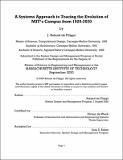| dc.contributor.advisor | de Weck, Olivier | |
| dc.contributor.author | De Filippi, J. Roland. | en_US |
| dc.contributor.other | Massachusetts Institute of Technology. Engineering and Management Program. | en_US |
| dc.contributor.other | System Design and Management Program. | en_US |
| dc.date.accessioned | 2021-12-17T17:04:25Z | |
| dc.date.available | 2021-12-17T17:04:25Z | |
| dc.date.copyright | 2020 | en_US |
| dc.date.issued | 2020 | en_US |
| dc.identifier.uri | https://hdl.handle.net/1721.1/138513 | |
| dc.description | Thesis: S.M. in Engineering and Management, Massachusetts Institute of Technology, System Design and Management Program, September, 2020 | en_US |
| dc.description | Cataloged from the official version of thesis. Vita. | en_US |
| dc.description | Includes bibliographical references (pages 145-146). | en_US |
| dc.description.abstract | MIT offers many unique opportunities to its students. I chose to take a path less traveled and investigate with a systems view the evolution of MIT's main campus by considering its population, finances, spaces, and their purpose in an integrated way. Over a century of population, building and financial data was integrated dating back to 1940. MIT's main campus, opened in 1916 on a 50-acre site along the Charles River in Cambridge, Massachusetts, has grown in the past century from a campus of 978,000 to 11,261,000 square feet, or a factor of approximately 11.5. The population has grown from 2,374 students, 117 faculty, and an estimated 726 staff to 11,574 students, 1,056 faculty, and 11,651 staff, or a factor of approximately 7.5. From 1940 to 1946, research expenditures per faculty, in 2019 dollars, grew from $1470/year/faculty member to $231,000/year/faculty member. By 2019 this number was $740,000/year/faculty member. A structured organization of the data into decade-length time periods and detailed analysis of this data confirms the hypothesis that a correlation exists between population and funding as educational and research activities drive the building of functional space as a supply to meet this evolving demand. These data also show an evolution from a university mission of training engineers' mens et manus, - minds and hands - to a mission of state-of-the-art research to advance both science and industry. While the findings are conclusive, they are not so strong as to offer a predictive capability; the future history of MIT's campus is yet to be written. However, the systems analysis presented here should assist in creating realistic scenarios that are grounded in validated ratios of population (faculty, students and staff), finances, spaces and activities that are all linked to each other. I detail possible directions for further research that might strengthen the relationships across the campus-wide systems model so that it can be used to predict or at least bound future scenarios based on varying demand inputs. In light of the coronavirus disease 2019 (COVID-19) pandemic, a systems-level understanding of how changes to the campus population and/or funding creates emergent changes to space needs offers MIT's planners the ability to respond more quickly and with more accuracy. | en_US |
| dc.description.statementofresponsibility | by J. Roland de Filippi. | en_US |
| dc.format.extent | 146 pages | en_US |
| dc.language.iso | eng | en_US |
| dc.publisher | Massachusetts Institute of Technology | en_US |
| dc.rights | MIT theses may be protected by copyright. Please reuse MIT thesis content according to the MIT Libraries Permissions Policy, which is available through the URL provided. | en_US |
| dc.rights.uri | http://dspace.mit.edu/handle/1721.1/7582 | en_US |
| dc.subject | Engineering and Management Program. | en_US |
| dc.subject | System Design and Management Program. | en_US |
| dc.title | A systems approach to tracing the evolution of MIT's campus from 1920-2020 | en_US |
| dc.type | Thesis | en_US |
| dc.description.degree | S.M. in Engineering and Management | en_US |
| dc.contributor.department | Massachusetts Institute of Technology. Engineering and Management Program | en_US |
| dc.identifier.oclc | 1275433641 | en_US |
| dc.description.collection | S.M. in Engineering and Management Massachusetts Institute of Technology, System Design and Management Program | en_US |
| dspace.imported | 2021-12-17T17:04:25Z | en_US |
| mit.thesis.degree | Master | en_US |
| mit.thesis.department | SysDes | en_US |
